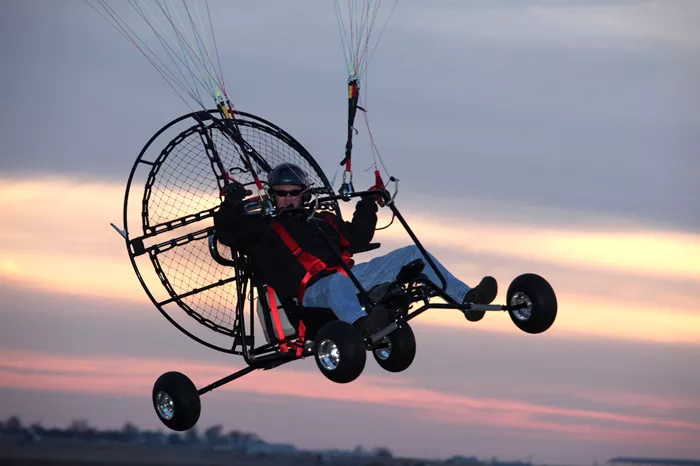Paragliding with a motor, often referred to as powered paragliding (PPG), offers a thrilling way to experience the skies. Unlike traditional paragliding, which relies solely on wind and thermal currents, powered paragliding equips you with a motor that provides additional thrust. This enables you to take off from flat ground and maintain control even in less-than-ideal weather conditions. In this comprehensive guide, we’ll delve into the best motorized paragliders available, their key features, and what makes them stand out.
Understanding Powered Paragliding
Powered paragliding combines the freedom of flight with the stability of a motor. This section explores the fundamental aspects of PPG, including its benefits, components, and operational basics.
What is Powered Paragliding?
Powered paragliding involves a paraglider wing combined with a motorized harness, known as a power unit or paramotor. The motor, usually a two-stroke or four-stroke engine, propels the pilot into the air, providing the lift needed to take off and sustain flight. This allows for longer flights and the ability to control altitude and direction more precisely compared to traditional paragliding.
Components of a Powered Paraglider
A powered paraglider consists of three main components:
The Wing: The paraglider wing is similar to that used in non-motorized paragliding but may be designed to handle the additional weight and thrust.
The Harness: The harness supports the pilot and is equipped with the power unit.
The Power Unit: This includes the engine, fuel tank, and propeller, which generate thrust.
Key Features to Look for in a Motorized Paraglider
When choosing the best motorized paraglider, consider the following key features:
Engine Type and Performance
The engine’s type and performance are crucial. Most powered paragliders use two-stroke or four-stroke engines. Two-stroke engines are lighter and more powerful but may require more maintenance. Four-stroke engines are heavier but generally more reliable and fuel-efficient.
Weight and Portability
The weight of the power unit impacts both performance and ease of transport. Lighter units are preferable for ease of handling and portability, especially if you need to transport your gear frequently.
Wing Design and Compatibility
The wing’s design should match the power unit’s specifications to ensure optimal performance. Some wings are designed specifically for powered paragliding, with features that enhance stability and maneuverability.
Build Quality and Durability
Durability is essential for safety and long-term use. High-quality materials and construction can withstand the rigors of frequent flights and varying weather conditions.
Top Motorized Paragliders on the Market
Here we highlight some of the best motorized paragliders available, based on performance, features, and user reviews.
1. Parajet Maverick
The Parajet Maverick is renowned for its versatility and reliability. This model features a powerful four-stroke engine and a robust frame that provides excellent stability. The Maverick’s lightweight design makes it easy to handle, and its engine is known for smooth operation and low noise levels.
2. Fly Products Moster 185
The Fly Products Moster 185 is a popular choice among experienced pilots. It boasts a powerful 185cc engine, offering impressive thrust and efficiency. The Moster 185’s compact design and advanced materials ensure durability and ease of transport.
3. PAP 250
The PAP 250 stands out for its high performance and innovative features. With a 250cc engine, it provides ample power for various flight conditions. The PAP 250 is designed for comfort and control, featuring an ergonomic harness and advanced suspension system.
4. Air Conception Tornado 280
The Air Conception Tornado 280 offers a blend of power and agility. Its 280cc engine provides exceptional thrust, and the unit’s lightweight design enhances maneuverability. The Tornado 280 is ideal for pilots seeking both performance and ease of use.
Safety Considerations
Safety is paramount in powered paragliding. Here are some important considerations:
Pre-Flight Checks
Before each flight, conduct thorough pre-flight checks on both the paraglider wing and the power unit. Inspect for any signs of wear or damage, and ensure all components are functioning correctly.
see also: 11 Best Place for Paragliding
Maintenance and Care
Regular maintenance of the power unit is essential to prevent mechanical failures. Follow the manufacturer’s maintenance schedule and address any issues promptly.
Training and Certification
Proper training is crucial for safe powered paragliding. Enroll in a certified training program to learn the necessary skills and techniques. Many countries also require pilots to obtain certification before flying.
Conclusion
Choosing the best motorized paraglider involves evaluating key features such as engine performance, weight, and wing compatibility. Models like the Parajet Maverick, Fly Products Moster 185, PAP 250, and Air Conception Tornado 280 stand out for their performance and reliability. Prioritize safety through thorough pre-flight checks, regular maintenance, and proper training. With the right equipment and knowledge, powered paragliding can offer an exhilarating and safe flying experience.
FAQs:
How does powered paragliding differ from traditional paragliding?
Powered paragliding uses a motor to provide additional thrust, allowing for takeoff from flat ground and controlled flight in varying conditions. Traditional paragliding relies solely on wind and thermal currents for lift.
What should I consider when choosing a motorized paraglider?
Consider factors such as engine type and performance, weight and portability, wing design compatibility, and overall build quality and durability.
Is powered paragliding safe?
Powered paragliding is generally safe when proper procedures are followed. Ensure thorough pre-flight checks, regular maintenance, and receive adequate training.
How often should I perform maintenance on my powered paraglider?
Follow the manufacturer’s maintenance schedule for your power unit and inspect your equipment regularly for signs of wear or damage.
Do I need special training to fly a motorized paraglider?
Yes, proper training is essential for safe powered paragliding. Enroll in a certified training program to learn the necessary skills and techniques.
related topics:

